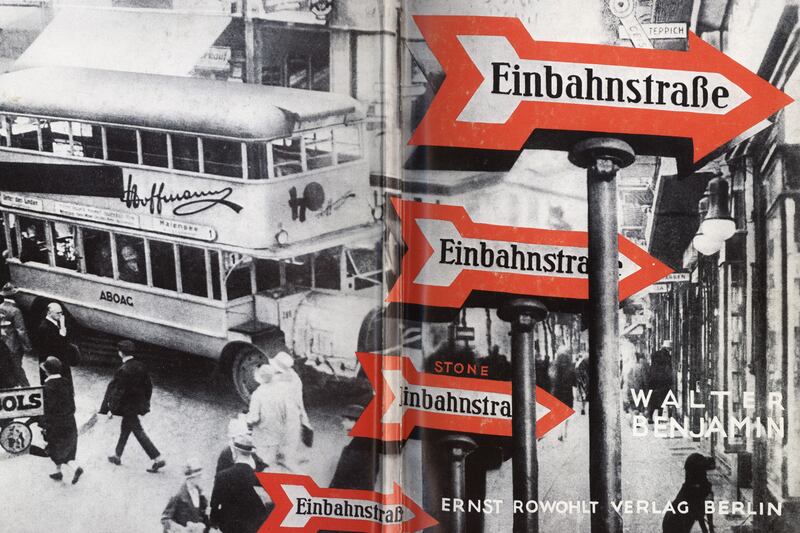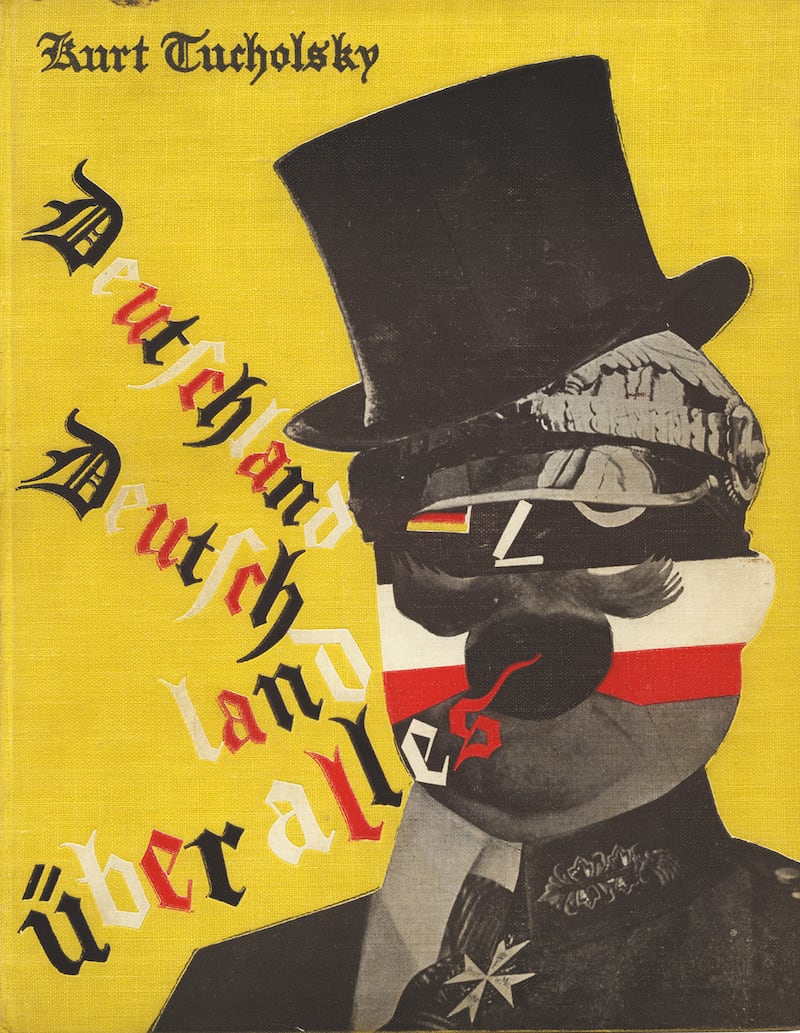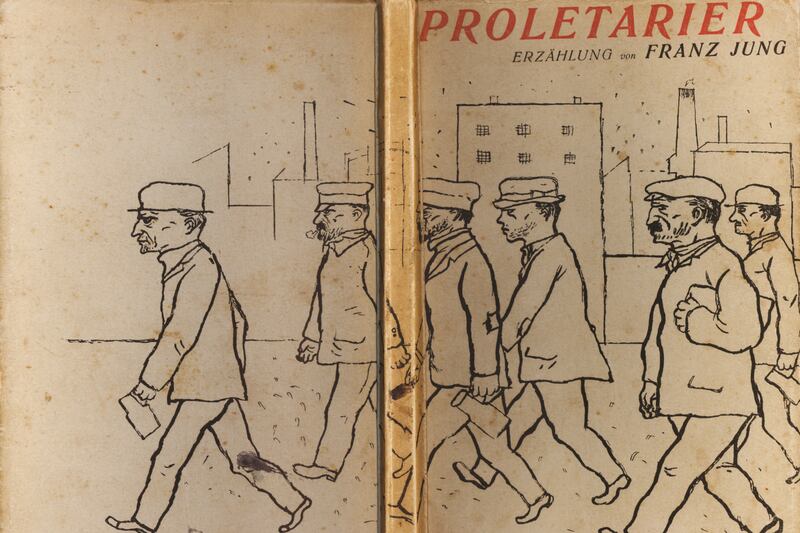Suddenly, it’s Weimar time again: “New Objectivity: Modern German Art in the Weimar Republic, 1919-1933” is on exhibit at the Los Angeles County Museum of Art; the Neue Galerie, in Manhattan, has mounted a riveting, unsettling show called “Berlin Metropolis: 1918-1933”; and Taschen has just released The Book Cover in the Weimar Republic, a mammoth, handsomely produced tome edited by Jürgen Holstein, a historian of book design who cherry-picked, from his private collection, the covers and jackets of 1,000 books produced between 1919 and 1933 by some 250 Berlin publishers. Oh, and here’s an invitation, in my Inbox, to something called “Visions of Weimar,” a themed event created by the New York-based Dances of Vice. The hosts dangle the promise of a night in ’30s Berlin, savoring “Weimar decadence at its finest with characters plucked from the cabarets, the cinema, and the streets.”
What conjunction of collective fears and daydreams makes some random piece of the past suddenly relevant? Is retro, like Hollywood’s never-ending reboots and remakes, just one more example of the creative bankruptcy of post-postmodern culture? Or do we conjure up the past in uncertain times because the dead have always been oracles, and we hope they can show us the way out of the mess we’ve made, into a better future?

The parallels between our moment and the Weimar era aren’t exact: the dollar is strong, unlike the famously worthless Mark (one trillion to the buck in November 1923), and the mordant satire of Berlin Dadaists like Hannah Höch, John Heartfield, and George Grosz is nowhere to be seen. But the world they caricatured with savage glee—a depraved, corrupt society where piggish capitalists paw syphilitic whores and starving families eat scrap metal and “war cripples with crustacean-like steel arms” (Grosz) lurch through the streets—isn’t so far from the grotesque farce we’re living.
Weimar Berlin was a place where “hate exploded suddenly, without warning, out of nowhere” (Christopher Isherwood, Goodbye to Berlin) in street battles, withcommunists and Spartacists (revolutionary socialists) on the left, Nazis and nationalists on the right. In America in 2015, we chalk up numbingly common mass shootings and “officer-involved” killings of black men to the psychopathology of everyday life. Anti-government “patriots” like the Oath Keepers flaunt their big, swinging semi-automatics in public. Paranoid visions of “Herr Hitlery” Clinton as our pant-suited führer dance in their heads, fueled by talk of the gunpoint disarmament of the citizenry and concentration camps for members of the militia movement. And standing in for the Little Corporal with the floppy forelock, we’ve got The Donald with the unconvincing comb-over. Trump’s blend of know-nothing nativism, fratboy vulgarity, and what we’ll call WTF—? Populism (Tax cuts for the wealthy! Every man a king!) would’ve brought the house down in a Munich beer hall in 1923. Eyes narrowed in smug contempt, mouth puckered sphincter-like as he courts the Mexican rapist vote, his is a face made for George Grosz.
“But what good’s permitting some prophet of doom/ to wipe every smile away?” Life goes on, and the courage of the German avant-gardists and graphic artists who risked their necks to expose the terror that would soon engulf their rickety democracy ought to shame us into standing up to the demagogues and goon squads of our day.

In documenting the creative exuberance of jacket art and design during the brief, doomed life of Germany’s first experiment in democracy, The Book Cover in the Weimar Republic reminds us that even a commercial artform can give shape to revolutionary impulses. To be sure, not every cover in Holstein’s anthology uses radical visual rhetoric (though many do). But in a society in economic and political free-fall, where desperation drove secretaries and shopkeepers and “every high school boy who wanted to earn some money” (Stefan Zweig, The World of Yesterday) to peddle their flesh, and where a gang of Nazis could beat a man to a bloody pulp while a knot of policemen “magnificently disregarded the whole affair” (Isherwood), the simple act of asserting an individual vision, and of casting an aesthetic vote for meaning and order, could be a political statement.
That said, the influence of Modernist avant-gardism—Expressionism, Constructivism, Dadaist photomontage, Neue Sachlichkeit (social-realist “New Objectivity”), The Bauhaus—was everywhere in Weimar book design. The republic witnessed “the heyday of German book culture,” says Holstein, in his introduction to The Book Cover in the Weimar Republic, and “Berlin was the epicenter of book production and avant-garde experimentation in the book arts.” With its venerable academic and cultural institutions and hopped-up nightlife, the city of four million was a capital of European culture. Berliners were bibliomaniacs, supporting numerous public libraries, university libraries, specialized libraries (scientific and otherwise), bibliophilic societies, sidewalk vendors, and bookstores—1,879 of them, to be exact.

Giddy to be free of the heel-clicking conservatism of the German Empire (abolished when Kaiser Wilhelm II abdicated in November 1918 and the republic was born), liberal and left-wing Berlin publishers were quick to embrace cutting-edge ideas about the book cover as advertising platform and artistic medium. As Holstein notes, the work of vanguard designers and illustrators such as Herbert Bayer, Georg Salter, Jan Tschichold, Frans Masereel, and Paul Urban “gave rise to innovative, imaginative jackets that aroused peoples’ curiosity, but were also sometimes startling and aggressive.” Dynamic, sans-serif typography and even hand-lettered script were in; the Blackletter/Fraktur and roman/antiqua typefaces associated with the Prussian militarism and conservatism of Imperial Germany were out. In the egalitarian spirit of the newborn democracy, some designers eschewed capital letters, setting their book titles entirely in lowercase. Photomontage, a technique pioneered by Berlin Dadaists such as Grosz and Heartfield, quickly established itself as a shockingly new mode of address—the ’20s version of Photoshop—that cut through the visual cacophony of Berlin’s newsstands and bookshops.
Heartfield was the Banksy of his day. A committed communist and provocateur par excellence, he earned the Nazis’ wrath—and a hasty exit to England, in 1938—with mordantly funny montages that sneered Hitler and his henchmen down to size. (Some of his greatest hits are included in the stunning catalog for the Neue Galerie show. In Adolf the Superman Swallows Gold and Spouts Rubbish (1932), an X-ray—a real one, seamlessly collaged onto Der Fuhrer’s belly—reveals all the deutschmarks he’s gobbled up. In The Meaning Behind the Hitler Salute (1932), a capitalist greases Hitler’s conveniently upraised palm with a wad of bucks.)
Heartfield’s mastery of photomontage is equally evident in the bold, provocative jackets he created as house designer for Malik-Verlag, the Berlin publishing house founded by his brother Wieland. Always the innovator, he brainstormed the gimmick of wrapping cover illustrations around, onto jacket flaps, and moving flap copy onto the back cover, where its come-on would be more likely to seduce the hurried browser. If putting his propaganda genius at the service of the profit motive irked the communist in him, you’d never know it from the arresting examples of his work on display in The Book Cover in the Weimar Republic.
Of course, Malik-Verlag was a left-leaning house, so most of the books he designed harmonized with his politics. For Levisite, a book warning of the potential use of the poison gas Lewisite against the unruly proletariat in class wars to come, he uses blaring type and ghastly images of men and horses in gas masks to convey the horror of chemical warfare. His cover for Kurt Tucholsky’s pointed commentary on German history, Deutschland, Deutschland Über Alles (1929), is rightly one of his most famous images. Collaged from snippets of photos and colored paper, a jowly, top-hatted figure in a Junker‘s military tunic, with the regulation-issue mustache, spits out the title in Fraktur type. (Heartfield’s ironic usage of the quintessential Teutonic typeface is a nice touch.) Four years later, another mustachioed cartoon of a man would rouse the rabble to murderous fury with word balloons full of Fraktur, putting a bullet in the head of German democracy.

The Book Cover in the Weimar Republic debunks the myth, handed down from Isherwood to Cabaret to—god help us—Amanda Palmer back in her Dresden Dolls days, vamping it up in a corset and garter belt on loan from Dietrich in The Blue Angel, that the Weimar was all Brecht-Weill songs and The Cabinet of Dr. Caligari and monocle-wearing lesbians with riding crops. The exploding mass media, not just the gay demimonde and the avant-garde, were part of the cultural ferment, too. Just look at the photomontage Sasha Stone created for Walter Benjamin’s Einbahnstraße, its red, black, and white street signs repeating across the cover in a honking visual echo. Or the hyperkinetic cover of a film-themed issue of the avant-garde magazine G, its overprinted type and scraps of movie film pinwheeling toward us at crazy angles, creating an almost 3-D illusion of depth and dynamism. Here’s George Grosz’s cover for Franz Jung’s Proletarier, a pen-and-ink drawing of grim-faced workers shambling zombie-like across the front of the book, onto the spine, and over the back. And Frans Masereel’s red-and-black cover for Upton Sinclair’s Captain of Industry, a portrait of an industrialist made entirely of numbers, the cold calculus of capitalism personified. And Jan Tschichold’s stripped-down, modernist covers, their big, bold, sans-serif type alone in the spotlight, free at last from playing second fiddle to illustration. (If his name sounds familiar, that’s because Penguin recruited him, in the late ’40s, to standardize and subtly refine the iconic design of its orange-and-white paperbacks.)
A book’s cover isn’t just inseparable from a book’s contents, it’s of a piece with the spirit of its age. “The speed with which a liberal, enlightened, internationally minded spirit made itself heard—if not outright prevailed—after the fall of the German empire always seems like a miracle,” says Christoph Stölzl, in his foreword to The Book Cover in the Weimar Republic. For him, the artistic innovation and intellectual vitality of Weimar book culture “proves that democratic Germany had every chance to become a model incubator for an ideal global culture.”
But the German volk, rallying around a frenzied, gesticulating popinjay with bad hair and some truly nasty ideas about race and nation, had other ideas. “There was no going back after January 30, 1933,” Stölzl writes, “when most of this culture”—Weimar’s progressive literary and publishing scene, he means—“was trampled and burned, its creators persecuted or driven out of the country.” One of the Nazis’ first orders of business, naturally, was to make a bonfire of dangerous ideas: on May 10, 1933, in 34 cities, gleeful mobs burned subversive, “un-German” books by the boatload.
In Römerberg Square in Frankfurt, where one of those pyres reduced thousands of books to a heap of ash, a plaque now memorializes the moment one of Europe’s best-read, most cultured nations opened the bilge-cocks of its ugliest impulses. The plaque bears an admonitory quote from the 19th-century German-Jewish poet Heinrich Heine: “Dort, wo man Bücher verbrennt, verbrennt man am Ende auch Menschen”: “Wherever they burn books they will also, in the end, burn human beings.”






